Western Images of Islam
H V Brasted

One of the least contentious challenges Samuel P. Huntington recently threw down in his provocative and testing "clash of civilisations" thesis was the exhortation that the West "develop a more profound understanding of the basic religious and philosophical assumptions underlying other civilisations" 1. The civilisation Huntington wanted us to get to know in particular was the Islamic. This is where he did become contentious. For, the underlying reason he implied why we should understand Muslims better, was that we should "know our enemy". This was put forward principally as a first step to ensure a state of peaceful coexistence in the world - a noble motivation - though practically, I suspect, to get the drop on our future protagonists should the "worst come to the worst".
The "worst" would be the "Mother-of-all-Conflicts", "a clash of civilisations", in which the West would line up and eventually come to blows with the Islamic world - possibly allied with the Confucian or Chinese - along, what he calls, the "faultlines of contact".
I will return to Huntington later. Suffice it to say, at this juncture, that he rightly argues that not only the West's, but also the world's, "understanding" of Islam, as a religious system of beliefs and practice, is somewhat less than profound.
A View From Australia
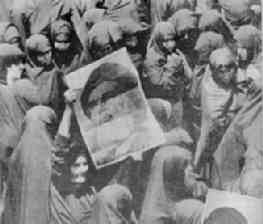
|
This is not surprising when so many reports are taken from the agencies - Reuters, AFP, UPI - and reproduced in the news columns of Australia's major newspapers. In addition numerous feature articles borrowed direct from The Times, the Guardian, the Washington Post, appear in the editorial pages on a regular basis. The result is a degree of common, syndicated reporting.
This is not to deny that Australian attitudes to Islam, its images of it, may diverge from the Western standard, and may be in the process of doing so more now. Indeed, Australia is classified in one of Huntington's footnotes as a "torn country". A "torn" country is defined as a country with a "fair degree of cultural homogeneity", but one which seeks to jump the cultural divide2. Australia is deemed to be attempting to make that leap by renouncing its membership in the West, and redefining itself as Asian. However, in Huntington's view, the attempt is destined to fail.
Negative ProjectionHow has Islamic culture been defined or imaged?
In the last two centuries that imaging was basically dismissive and pejorative, since it arose out of the West's subjugation of Muslim peoples everywhere. According to Peter Mansfield, in his book The Arabs, Islamic culture tended to be encapsulated through a number of very general, although defining stock stereotypes 3.
Thus Islam as a religion - compared with Christianity - was negatively classified as: "fanatical", "bloodthirsty" and "socially repressive". The people who embraced it - Muslims - were indiscriminately lumped together as "deceitful", "irrational" and "uncivilised". And the countries, in which Islam flourishes, were categorised as "materially backward", "poverty stricken" and invariably "despotic".
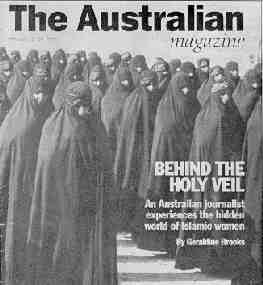
|
In short, much of the visual imagery emerging from this imperialist encounter dealt less with Islam as a religion and culture, than with the postcard portrayal of the Orient as: dirty, sleezy, mysterious, exotic and disorderly. The focus then was on Islam as a fallen world system, a civilisation in marked decline.
Today, even if this genre has not entirely disappeared, the focus seems very much to be on Islam as a rival world system. This is a system that is no longer despised, but is beginning to be taken seriously - even feared.
But it is feared mostly, it would seem, for the wrong reasons. A new typology of images to accommodate post-colonial changes and circumstances has emerged to categorise Islam as intrinsically: fundamentalist, militant, anti-West, and socially and politically repressive.
That Muslims seem everywhere poised to engage in an insurrectionist crusade to "Islamicise" the world, along the lines established by Ayatollah Khomeini in Iran in 1979, is a spectre conjured up time and again in newspaper headlines, photographs, cartoons, and video clips.
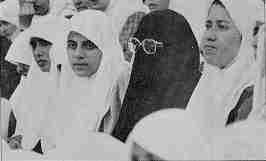
|
Recently, a new image - a doomsday image - has begun to take shape. With the collapse of the Soviet Union it would seem, as John Esposito has put it, that fundamentalist Islam has replaced expansionist communism as the new, virulent enemy threatening life, liberty and property in the so-called free world.
It is as if the old threat has re-emerged, but in Islamic form. Religious Stalinists have simply replaced secular Stalinists as the enemy hell-bent on destroying liberal democracy and capitalism, and Das Kapital has given way to the Quran as the ideological battle material 5. In effect a new Green menace has replaced the old Red one.
This is where Huntington's hypothesis about the nature of future conflict in the world fits into the picture. Briefly, Huntington puts the case that, with the cold war gone, but with competition and confrontation between countries likely to remain, the future battle-lines would be giant ones, drawn up at the civilisational level rather than as in the past at the national or ideological levels. Civilisations, he defines as the largest units of identity to which people adhere - each unit consisting of groups of culturally compatible countries. Thus the next world war would likely be between a Western bloc and an Islamic bloc 6.
Is not this all a bit fanciful 7? Many, perhaps most, scholars think so. One recently accused Huntington of writing transparent "balderdash" 8.But if it is "balderdash" it has struck a raw nerve somewhere.
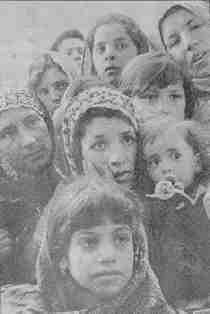
|
The disquiet seems to be that Huntington's "theory" has the potential to become paradigmatic, by acquiring the status of a predictive model of international relations more or less as the outdated cold war paradigm, it threatens to replace, did11. Should this occur, the "clash of civilisations" idea could be used to explain every development, every event in Islamic countries, regardless of the facts or circumstances.
To an extent this has already begun to happen. I refer to the "Survey on Islam" in the August 1994 Economist. Here Algeria, as once Vietnam before it, is treated as the barometer of things to come. In this article, Algeria, poised to fall to Islamic rebels, is described as a domino likely to set off a chain reaction across North Africa and beyond. Should "fundamentalism" begin to sweep the board in this way, it would only be a matter of time before an Islamintern emerged to coordinate further Islamic insurgency, elsewhere and everywhere.
Does this sound familiar? It should. It is exactly the rhetoric of the Cold War, even though it comes from an author who purports not to be convinced by the Huntington thesis. The section on Algeria is headlined: "a hand grenade in mid-flight", which is a metaphor of historically loaded, and highly suggestive symbolism.
In effect, Huntington seems to have constructed the ultimate stereotypical image - a doomsday image. Here is an image based not necessarily on any hard evidence, but essentially built on all the imagery that preceded it.
Snapshots of the StereotypesTo illustrate such stereotyping, I provide a glimpse of some of the visual images of Islam that I have collected over a period of years. For compression that glimpse has been confined to two themes: the subordination of women, and the militancy of Islam, the two most prominent and prevailing in the Western treatment.
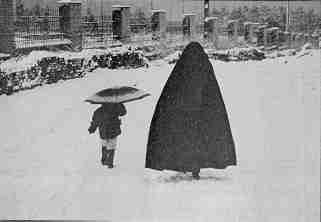
|
Figures 1-6, which date from 1990 to the present, purport to locate the position of women in Islamic society, a position that is deemed to be backward, subservient, and totally at odds with the kind of equality and rights Western women have managed to achieve throughout the twentieth century. The messages emanating from these images are unequivocal: conformity, repression, subordination, control. What is missing in all cases, however, is context.
Figure 1, for example, is a timeless photograph suggesting the unchanging, tortured reality for Iranian women in post-revolution Iran, even after the death of Ayatollah Khomeini and the passing of his fundamentalist regime. Figure 2 shows a group of women forlornly filing in line to somewhere, slowly, submissively, with resignation.
That Muslim women are for the most part presented collectively and anonymously as a crowd, and not as discrete individuals, is disturbing in the Western perception. Not that all women are veiled from head to foot in black chadors, only the most devout. The white hijab, in various forms, is far more common (Figure 3). While veiling is a sign of virtue, rather than subjugation or worse menace, the distinction is seldom made clear. The caption in Figure 5 tells the story.
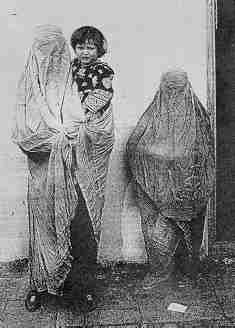
|
Figure 8 is suggestive of how formidable a foe Islam has become: monolithic, heroic, modern rather than medieval, a contemporary Saladin perhaps. But it is the role and positioning of women in society which is conjured up as the theatre of most immediate and symbolic confrontation.
At first glance Figure 9 depicts dichotomy and difference. But it could equally, on reflection, show two women walking comfortably side by side, virtue registered in not incompatible Western and Islamic senses. Not that this is the point intended to be drawn. The image is designed to spell out in simple, black and white terms what is perceived to be at stake: an egalitarian free society or a patriarchal restrictive one. In such a conflict Western and Islamic women will unavoidably find themselves on opposite sides, the latter constituting a formidable warrior contingent in the resulting showdown.
When the "clash" comes it will be hard fought and violent, on the ground a war like any other. Figures 11-15 variously establish the relationship between Islam and violence. Mosque and Kalashnikov invariably go hand in hand. The Islamic world order seems to mean not only conflict, but censorship at the pain of death, and rough justice all round.
Figures 13-15 play up the West's bewilderment and horror both at the bounty placed on Salman Rushdie for his writing of Satanic Verses and the baying for Taslima Nasreen's blood for blasphemy. In fact Islam is in a "state of rage". The domino effect, if it is most apparent in the North African context, is poised to engulf Asia as well. Not even Australia will be immune from its effect.
Figure 16 suggests that a Muslim invasion of residential areas in 'Australia' is imminent and already under way. Indeed, certain suburbs are showing signs of being overrun by mosques. It is only a question of time before 'fundamentalist' Islam, armed to the teeth and prepared for war, manifests itself not only in the war-torn Middle-East but eventually in downtown Sydney as well (Figure 17).
Figure 18 is a small, almost unnoticeable motif which accompanies a series of articles on the theme of Islamic and Australian cultures interacting and harmonising. Considerably magnified, however, it conveys the message, unintended by the author, of multi-culturalism in Australia ultimately leading to the erosion of Australian identity - in this case by Islamicising the Sydney Harbour Bridge, a national icon.
Process of ReductionismIf all this stereotyping of Islam is summed up, what emerges?
As the Australian newspaper confessed on 9 November 1993, a pretty lopsided view of Islam is produced12.It is a view that does little to explain the perplexing "fundamentalist" phenomenon or why Muslims are exhibiting a growing bloc of disagreement with Western values and aspirations. For what the stereotyping has done is basically to subject Islam to a process of reductionism, which does not so much explain Muslim behaviour and ideology, as tend to explain everything about them away.
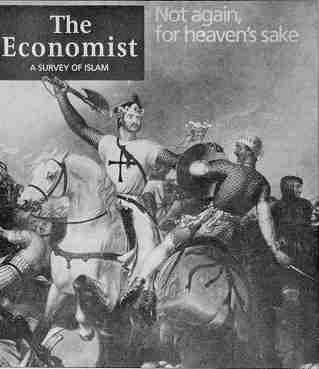
|
Regardless of cultural diversity and geographical location, Muslims everywhere tend to be indiscriminately lumped together as an almost "identikit" species: a people of fanatical faith, responsive to the call of religious leaders to topple liberal, particularly secular governments, and to set up in their place, essentially anti-modernist regimes.
Secondly, "Muslimness" tends to be defined and measured against Middle Eastern patterns of Islamic culture. The Middle Eastern Orient is doggedly turned to by the press as the pole star of Islamic developments. Thus regardless of where Muslims happen to reside - in Australia or India - they will be associated with what has happened and what is happening in the Middle East: with hijackings, hostage-taking, oil embargos, the Iranian Revolution, the Arab-Israeli conflict, the gulf war, and so on and so forth.
The cry for Australian Muslims to be repatriated, when some of them dared to question Australia's involvement in the gulf war, may be recalled here. "Go Home", was John Law's clarion message on Sydney Morning Radio 2UE. "It's all very simple . . . If you wish to condemn Australia's involvement in the Middle East on personal grounds, then go home." But to where: to Egypt? to Saudi Arabia? to Syria? to Pakistan? countries which formed part of the UN Front against Saddam Hussein. Sydney Radio was subsequently jammed with calls calling for the internment of Muslim Australians and for a "review of the nation's treason laws"15.
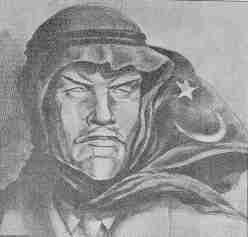
|
The most recent example of such associations being drawn occurred in response to the bombing of the Alfred Murrah building in Oklahoma City in the USA in April 1994. In an article entitled, "Counterblast", it was reported that American anger was being directed at Muslims as the likely perpetrators. The sub-headline said it all: "Americans want someone to pay, preferably a Muslim"16.
Thirdly, there is the conformity and resilience of the imagery of Islam. What emerges clearly from a search of newspapers and journals over the last twenty years or so, is the uniformity and sameness of the graphic portrayal. The imagery linking Mosques, Muslims, and Militancy simply has not gone away. This is despite the fact that increasingly journalists and scholars have decried the imagery as misleading, and have looked to have it modified or removed altogether.
To no avail! The graphic imagery has remained, even where juxtaposed against a text that may convey, certainly in recent times, a radically different message. It is not unusual for an accompanying photograph, cartoon or headline to contradict the substance of the articles they are presumably designed to illustrate.
Why should this be? Was there "something" special about Islam that has singled it out for special treatment - in a way not apparently reserved for Buddhism or Hinduism?
Why This Targeting?What explanations can be ventured? The most obvious is Edward Said's, who put the case in his now famous 1978 critique of Western studies of the Orient, that the West's misunderstanding of Islamic culture stemmed directly from the way scholars, novelists, journalists and agencies of the state had misrepresented it. By portraying Europe as an area of superior culture and the "orient", when compared with it, as an area of patently inferior culture, they proceeded to divide the world into civilised "us" and uncivilised "them" categories.
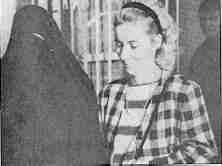
|
Has Said got it right? For the most part it would seem so18.The Western literature on the "orient", which he decodes, is clearly full of the type of "orientalism" he describes. The trouble is that it pertains specifically to the age of imperialism, which has long gone - at least in its 19th century form. It may be doubted that scholarly opinion today would be at all persuaded by T B Macaulay's arrogant dismissal of Arabic and Sanskit learning as less substantial than that to be found on a "single shelf" of an English public schoolboy's personal library19.Indeed, the current texts on Islam that command respect - by Akbar Ahmed, John Esposito, Fazlur Rahman, for example - have confronted "orientalism" and done their best to expose and neutralise it.
There may, of course, be a residual orientalism, especially at the school level, where there seems to be no "use-by" date on texts dusted down year after year and recycled until they disintegrate. A 1984 study of fifteen of the most commonly used social science school textbooks in the Australian state of Victoria attests that orientalism is alive and well in them20.
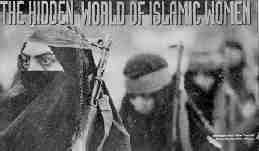
|
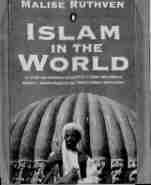
|
What newspaper or magazine article on the situation in Iran, for example, is not accompanied still by the mandatory picture of Ayatollah Khomeini? What exposé on female rights in Muslim society is not juxtaposed against photographs of Muslim women which does not confront head-on the positioning of women in Western society?
It does not seem to matter that individual journalists can point out that: Islam has been "bedevilled by Western clichés"21,that there is nothing to fear about it22;that it is simply a religion whose adherents "actually practice what they believe in"23. Importantly, the blazing headline and glaring photograph have conveyed something completely different. In the period I have reviewed, the headlines encapsulating Islam in a few bold capitals have been repetitive, sensation- alising and standardising.
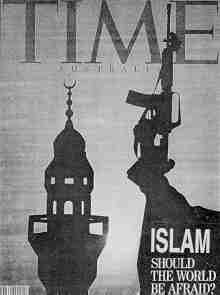
|
These demonstrate the point-just how repetitive and reinforcing the headline treatment of Islam in the press has been. It hardly needs decoding. Yet more often than not, the headlines and texts actually conflict. There was a conjunction in the 1950s newspapers; but this conjunction is more the exception than the rule in the 1990s.
Newspapers, of course, are not unbiased disseminators of news, but are competing players in the business of selling news and primarily themselves, a business that is clearly better served when the news they contain is topical, shocking, or eye-catching. What sells, according to the editor of the Sydney Morning Herald in 1990, is conflict and disputation24.It follows that the same sort of headlines keep reappearing, even though the old-fashioned articles have largely disappeared.
In such an environment, the premium is on imaging not coverage, and in the age of fast-food knowledge, newspapers are scanned rather than studied. The headline can be left "saying it all", if in a truncated, impressionistic and misinforming way.
There is also the factor of Islamic Identity. Muslim societies - as others - are involved in what Professor Shboul of Sydney University has called a "deep-felt" and "frantic" search for cultural identity, as they are increasingly assailed on a broad front by: secular principles, secular morality, and modern technology25.There is nothing unusual about that.
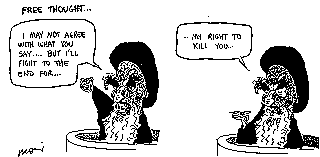
|
To judge from both a series of articles run by the Sydney Morning Herald in May 1995, entitled "Beyond Fundamentalism", and the Congress of the Australian Federation of Islamic Councils (AFIC) held in April last year (1994), the Muslim community in Australia seems to have adopted a survival strategy of not so much adapting Islam to the Australian environment, as protecting Islam from that environment27.
This has involved the attempt to set up, as an AFIC spokesperson put it, Muslim islands within the Australian Commonwealth, islands intended to become self-sufficient with their own schools, own shops, own newspapers and radio stations, own language - Arabic - being used28.The same movement may be observed in the British context.
Ultimately, of course, in claiming the right to be different, Muslims are seeking to be governed by the Sharia - the "Path" laid down by God - which requires a modification of the Australian legal system and amounts to claiming an extra-territoriality.
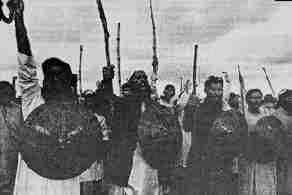
|
An article in the Australian is just a little too glib in stating last year that: "the real important difference between Islam and the West is that Islamic societies take religion seriously"29. The attempt by Muslims to live their lives according to God's law has political input too. For, can Australia, Britain or indeed India allow that it is not completely sovereign when it comes to organising the lives of all its citizens?
Can a sort of State within a State be easily attained, and can it be attained without changing the original edifice30? Will the transformation of New South Wales into "New South Asia", as the Sydney Morning Herald recently put it, take place without resistance?
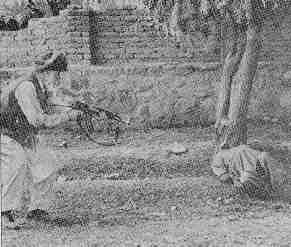
|
In August 1994 the Weekly Telegraph was drawn to confess that: "The West is undoubtedly prejudiced against Islam"31.It surely is, but is that prejudice entirely the result of ignorance, of imagery, of irrationality?
Indian RepercussionsGiven such persistent and uniform stereotypical coverage it follows that Western perception of distinct ethnic Muslim groups, such as the Muslim community in India, will be blurred at best. Doubtless some of the Middle East caricature attaches to this community by association.
It is true that since fundamentalism suddenly manifested in Hindu form, Muslims in India - as Muslims in Bosnia - have begun to be perceived as victims too rather than necessarily and always perpetrators of violence. The destruction of the Babri Mosque at Ayodhya certainly complicated the picture. Instead of fanatical Muslims, it was saffron-clad Hindus initiating mayhem and atrocity.
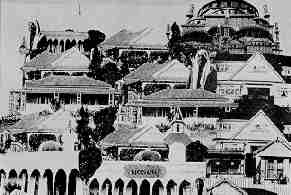
|
"Incomprehension" was the predominant response. "How is it", the Australian asked, "that basically united by faith in God, differing religions can be so antagonistic to one another? In a world increasingly secular and materialistic, it seems a foolhardy way to behave.33"Apart from ignoring the immediate past there was little attempt to get to the bottom of the fundamentalist phenomenon. That religious "fundamentalism" was not the preserve of Islam, but could appear in Hindu and other forms, and on the eve of the 21st century, was a point entirely missed.

|
A Muslim-owned paper like the Australian Muslim Times is a step in the right direction, but its reach is very small and its style of reporting is still largely rhetorical. What is needed perhaps is an internationally available and respected Muslim newspaper of record in the English language which journalists can currently consult in a number of university libraries and access on the Internet. This is one way, a potentially effective way, for Muslims to reappropriate the power to represent themselves.
Dr Howard Brasted is currently Associate Professor in Indian and Islamic History at the University of New England, Armidale, Australia. Since 1984 he has been both Secretary of the South Asian Studies Association of Australia (SASA) and editor of the scholarly journal, 'South Asia'. Manushi content is reproduced on India Together with permission. Click here to visit the Manushi home page